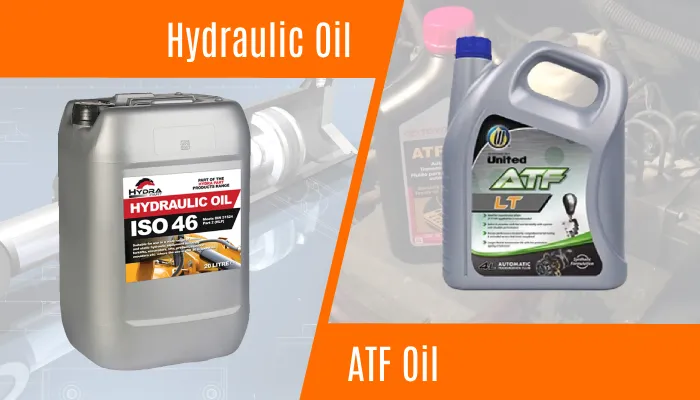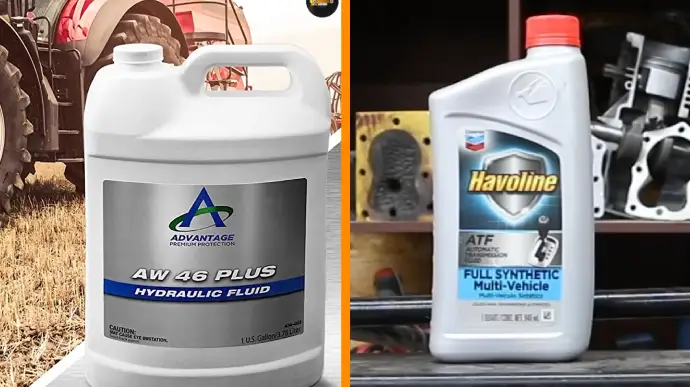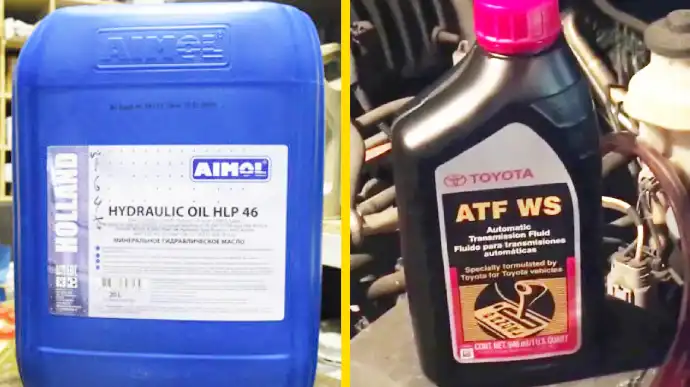Physical Address
304 North Cardinal St.
Dorchester Center, MA 02124
Physical Address
304 North Cardinal St.
Dorchester Center, MA 02124

Hydraulic oil and ATF (automatic transmission fluid) are two fluids vital to the efficient functioning of vehicles and equipment. While both serve the purposes of lubrication, cooling, and power transmission, they differ significantly in many aspects.
One major difference between hydraulic oil and ATF is their composition and additives. Hydraulic oil comprises various base oil types, including mineral oil, synthetic oil, and biodegradable oils.
Meanwhile, ATF is primarily designed with a specific blend of base oils tailored for automatic transmissions.
We will discuss in detail the key differences between hydraulic oil and ATF. So you can figure out which one to choose for your vehicle or equipment.

Hydraulic Oil and ATF are different in various aspects, and here are the key differences between them:
To understand the function and application differences between hydraulic oil and ATF, you need to know how they’re used in different vehicle systems.
Hydraulic oil is primarily used in hydraulic systems to transmit power, provide lubrication, dissipate heat, and offer corrosion protection.
It’s commonly found in construction equipment, agricultural machinery, automotive power steering systems, and aircraft hydraulic systems. Hydraulic oil is also used in vehicle systems such as automotive brakes, power steering systems, hydraulic lifts, and agricultural machinery.
On the other hand, ATF serves as a lubricant, coolant, and hydraulic fluid in automatic transmissions. It facilitates smooth gear shifts, cools transmission components, and maintains hydraulic pressure.
ATF is exclusively used in vehicles with automatic transmissions, including passenger cars, trucks, SUVs, and some commercial vehicles. It may also be used in power steering systems and 4WD transfer cases in some vehicles.
Hydraulic oil offers a wider range of base oil types, including mineral, synthetic, and biodegradable options, depending on the application. In contrast, ATF contains a combination of base oils specifically designed for automatic transmissions.
Regarding additives, ATF contains additives specifically designed for automatic transmission functions, such as enhanced lubrication, friction modification, and protection against rust and corrosion.
Conversely, hydraulic oil may contain additives customized for the needs of hydraulic systems, including anti-foaming agents, anti-wear agents, and antioxidants.
It’s crucial to note that vehicle manufacturers often specify ATF formulations. On the other hand, hydraulic oil offers more flexibility in choosing the right base oil and additives to meet the requirements of various hydraulic systems.
Hydraulic oil comes in various types, such as mineral-based, synthetic, and biodegradable oils. Each type is formulated to cater to different applications and environmental concerns.
Synthetic hydraulic oils offer improved performance over mineral-based oils, making them suitable for extreme conditions and high-pressure systems.
Meanwhile, ATF also comes in different types and formulations. Specific ATF specifications like DEXRON, MERCON, DEXRON VI, and MERCON V are designated by different vehicle manufacturers.
These formulations are essential to meet the requirements of various transmission systems and should be carefully selected to ensure compatibility and performance.
Hydraulic oil is known for its higher viscosity and is categorized into different classes based on temperature.
It has low viscosity for temperatures ranging from 0-35°C and medium viscosity for temperatures ranging from 35-80°C. There is a high viscosity for temperatures between 80°C and 110°C and a very high viscosity for temperatures above 110°C. This higher viscosity enables efficient power transmission in hydraulic systems operating at high pressures.
Conversely, ATF has lower viscosity compared to hydraulic oil. ATF, such as ATF III, is specifically formulated for a narrower temperature range.
Its dynamic viscosity decreases as the temperature increases, making it suitable for automatic transmissions but limiting its performance outside of its specified temperature range.

Hydraulic oil is known for its high purity, making it suitable for critical applications where contamination must be minimized. It’s designed to maintain the cleanliness of hydraulic systems.
Conversely, ATF is rich in detergents, which help keep automatic transmissions clean by trapping and suspending contaminants. This makes ATFs more suitable for applications in more contaminated environments.
However, the high detergent content in ATFs also leads to discussions about their use as engine cleaners, as they can trap more contamination before forming sludge.
Therefore, the cleanliness and detergent content of hydraulic oil and ATF play a significant role in their respective applications.
ATF is specifically formulated to provide the necessary friction properties for components such as clutches in automatic transmissions. It must carefully balance the static and dynamic friction coefficients to ensure smooth gear changes and minimize wear on transmission parts.
The friction properties of ATF are crucial for the overall performance of automatic transmissions, as they directly impact the shifting process and overall efficiency.
On the other hand, conventional hydraulic fluids, like hydraulic oil, don’t have the same requirement for precise friction properties as ATF. Hydraulic oil’s main focus is on power transmission, lubrication, and control in hydraulic systems.
While it does provide some level of friction, its primary function is to transmit power and lubricate the system rather than optimizing friction properties for precise component operation.
Hydraulic fluids rely on zinc additives to provide anti-wear properties, ensuring the protection of hydraulic pumps and components from damage caused by friction and wear. These additives help extend the service life of hydraulic systems.
In contrast, ATFs contain smaller quantities of zinc additives as their primary focus is on providing the necessary friction properties and wear protection for automatic transmissions. Instead, ATFs include high doses of VI improvers to maintain the fluid’s viscosity across a wide temperature range.
The VI improvers in ATFs help the fluid maintain its viscosity, ensuring the smooth operation of the automatic transmission. However, over time, these VI improvers may shear and impact the viscosity of the fluid, which isn’t a concern for traditional hydraulic oils.
When selecting hydraulic oil or ATF for your equipment, it’s essential to consider the OEM’s specific requirements. While hydraulic oil formulations generally have lower OEM specificity compared to ATF, it’s still crucial to adhere to manufacturer recommendations.
OEM specificity refers to the unique requirements set by original equipment manufacturers for the fluid’s composition and performance characteristics.
These requirements are based on the design, materials, and operating conditions of the equipment. Using the wrong type or formulation of fluid can lead to performance issues, decreased efficiency, and potential damage to the equipment.
Therefore, it’s crucial to consult the OEM’s guidelines or contact their technical support to ensure the correct fluid is used, guaranteeing optimal performance and longevity of the equipment.
ISO VG grades are used to classify hydraulic oils based on their viscosity at 40°C. This helps users select the appropriate oil for their equipment. Common ISO VG grades for hydraulic oils include ISO 32, ISO 46, and ISO 68, among others.
On the other hand, ATF doesn’t use ISO VG grades for classification. Instead, it’s defined by specific OEM specifications or industry standards such as DEXRON or MERCON. Different vehicle models may require ATF formulations with distinct specifications.
This means that while hydraulic oils are classified based on ISO VG grades, ATF isn’t classified in the same way.
Hydraulic oil is specifically formulated to have low foaming characteristics. This is because foam in hydraulic systems can harm efficiency and performance. The presence of foam can lead to a reduction in the ability of the hydraulic system to transmit power effectively.
Meanwhile, while ATF may include anti-foaming additives, its primary focus is on friction properties and lubrication. Foam resistance isn’t as critical in automatic transmissions compared to hydraulic systems.
Hydraulic oil typically has a color that ranges from amber to light yellow, although it can vary. On the other hand, ATF is commonly red or green in color. This color difference allows for easy identification and differentiation between the two fluids.
Regarding smell, hydraulic oil generally doesn’t have a specific odor. However, ATF has a distinct petroleum-like odor that’s often noticeable. It’s important to note that if the ATF has a burnt smell, it may indicate the need for fluid replacement.
Monitoring the color and smell of hydraulic oil and ATF can help maintain the performance and longevity of your hydraulic systems and automatic transmissions.
| Aspects | Hydraulic Oil | ATF (Automatic Transmission Fluid) |
| Function and Application | Used in hydraulic systems for power transmission, lubrication, and heat dissipation. Found in construction equipment, automotive brakes, power steering, and hydraulic lifts. | Lubricant, coolant, and hydraulic fluid in automatic transmissions. Exclusive use in vehicles with automatic transmissions. May also be used in power steering and 4WD transfer cases. |
| Composition and Additives | Wide range of base oil types (mineral, synthetic, biodegradable) with additives for hydraulic systems. | Base oils specifically designed for automatic transmissions with additives for lubrication, friction modification, rust protection, and corrosion resistance. |
| Types and Formulations | Mineral, synthetic, and biodegradable options for different applications. | Various types and formulations (e.g., DEXRON, MERCON) specified by vehicle manufacturers for automatic transmissions. |
| Viscosity and Temperature Range | Higher viscosity for efficient power transmission in hydraulic systems. Temperature-dependent viscosity classes. | Lower viscosity, formulated for a narrower temperature range in automatic transmissions. Viscosity decreases with increasing temperature. |
| Cleanliness and Detergent Content | High purity for critical applications, minimizes contamination. | Rich in detergents to trap and suspend contaminants in automatic transmissions. More suitable for applications in contaminated environments. |
| Friction Properties | Primary focus on hydraulic power transmission, lubrication, and control. | Specifically formulated to provide precise friction properties for smooth gear shifts in automatic transmissions. |
| Zinc Additives (ZDDP) And VI Improvers | Relies on zinc additives for anti-wear properties in hydraulic systems. | Contains smaller quantities of zinc additives; uses VI improvers to maintain fluid viscosity in automatic transmissions. |
| OEM Specificity | Generally lower OEM specificity; adherence to manufacturer recommendations is still crucial. | Specific formulations required by OEMs for optimal performance in automatic transmissions. |
| ISO VG Grades | Classified based on ISO VG grades (e.g., ISO 32, ISO 46) for viscosity at 40°C. | Defined by specific OEM specifications or industry standards (e.g., DEXRON, MERCON); no ISO VG grades. |
| Foam Resistance | Formulated to have low foaming characteristics in hydraulic systems. | May include anti-foaming additives, but foam resistance is not as critical as in hydraulic systems. |
| Color and Smell | Color ranges from amber to light yellow. Typically no specific odor. | Commonly red or green in color. Has a distinct petroleum-like odor. Burnt smell may indicate the need for fluid replacement. |
You can use transmission fluid as hydraulic fluid, but it’s important to consider the specific operating conditions of your hydraulic unit. Transmission fluid is suitable for certain hydraulic systems if the operating temperature, flow rates, and pressure requirements are similar to what the transmission fluid can handle.
However, it’s crucial to be cautious of potentially undesirable additives present in transmission fluid that may not be suitable for all hydraulic systems.
While many hydraulic systems can function well with various fluids like engine oil, automatic transmission fluid, or hydraulic oil, it’s essential to match the fluid to the specific needs of the hydraulic system for optimal performance and longevity.
Therefore, it’s recommended to consult the manufacturer’s guidelines or seek professional advice when considering using transmission fluid as a hydraulic fluid.
The recommended intervals for changing hydraulic fluid can vary depending on factors such as the type of vehicle, usage, and manufacturer’s guidelines. Typically, it’s advisable to change the hydraulic fluid every 1,000 to 2,000 hours of operation or as recommended by the equipment manufacturer.
On the other hand, the recommended intervals for changing ATF usually range from 60,000 to 80,000 miles. However, it’s crucial to note that these intervals can differ based on your vehicle’s make and model.
To ensure that you’re following the correct maintenance schedule, it’s essential to consult your vehicle’s owner’s manual and adhere to the manufacturer’s recommendations.
Blending hydraulic fluid with transmission fluid is generally not recommended due to their different formulations and tailored properties for specific applications.
Hydraulic fluid is designed to operate under high pressure and transmit power in hydraulic systems, while automatic transmission fluid (ATF) acts as a lubricant and coolant in automatic transmissions.
Mixing these fluids can result in an ineffective combination that lacks the necessary characteristics for both hydraulic and transmission systems. This can lead to operational issues, reduced performance, and potential damage to the equipment.
The differences between hydraulic oil and ATF are monumental, affecting their function, composition, and suitability for various applications. Understanding these distinctions is crucial in ensuring your vehicle or equipment performs optimally and remains well-maintained.
Hydraulic oil is tailored for hydraulic systems, while ATF specializes in automatic transmissions. Whether it’s their composition, viscosity, cleanliness, or compatibility with OEM specifications, these fluids are not interchangeable.
Pay attention to these variations to make informed decisions about your vehicle or equipment’s maintenance and fluid requirements.